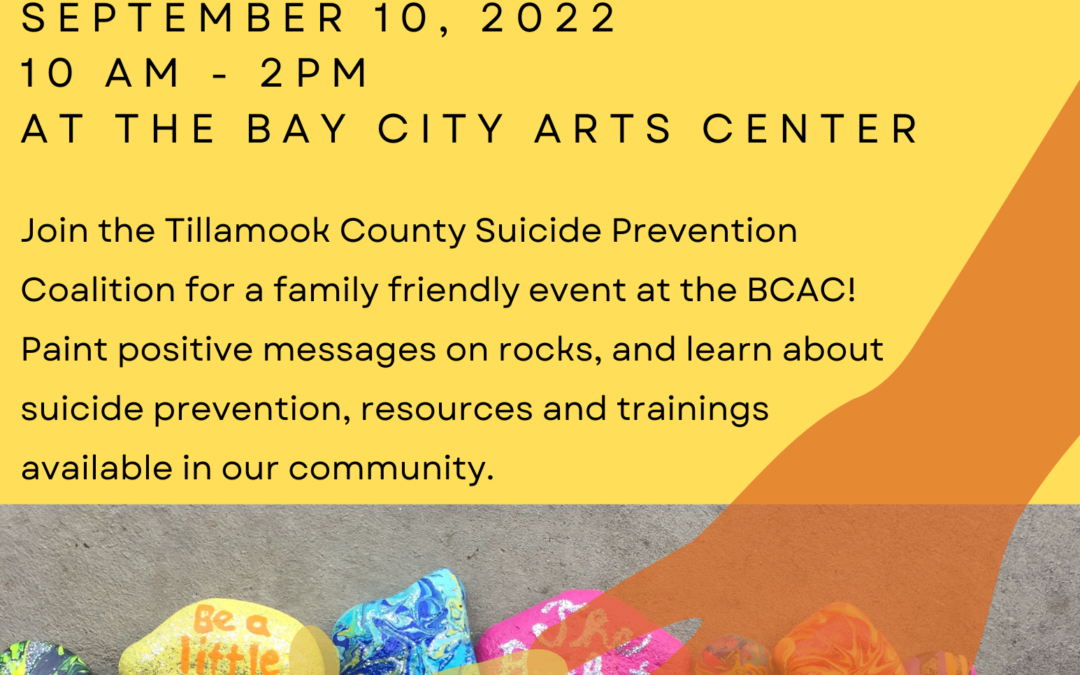
by Guest | Sep 6, 2022 | Being Well
Tillamook County Suicide Prevention Coalition is an emerging coalition. Dana Reynolds and Janeane Krongos, two members of the coalition shared this information about this coalition.
Can you tell me about the coalition?
The Tillamook County Suicide Prevention Coalition is a group of Tillamook County residents who are concerned about suicide. The coalition meets once a month to discuss strategies to raise awareness of suicide prevention, promote prevention education, and plan community events in Tillamook County. Entities engaged in this coalition include: Tillamook Family Counseling Center (TFCC), Optimal Life Coaching, Tides of Change, Veteran Services, City of Tillamook, Tillamook Police Department, Tillamook County Sheriff’s Office, Tillamook County Wellness, Tillamook County Community Health Center, Columbia Pacific CCO, Department of Human Services, Tillamook Bay Community College, Nestucca Valley School District, Neah-Kah-Nie School District, Tillamook School District 9, Value Yourself Counseling, and Adventist Health Tillamook.
How can people get involved with the coalition?
People who are interested in getting involved can email Janeane Krongos at Janeanek@tfcc.org.
What is the coalition’s focus?
Recently, the coalition has been focusing on organizing suicide prevention events, promoting suicide prevention trainings, and sharing resources and messages of hope. On September 10th, the coalition will hold a family friendly rock-painting event at the Bay City Arts Center (BCAC) from 10AM-2PM. At the event, community members will be encouraged to paint positive messages on rocks. The event will have an information table where community members can learn about suicide prevention. We are grateful for the community partners that have helped us make this event possible. Event sponsors include Columbia Pacific CCO (painting supplies), Averill Landscaping Materials INC (rock donation), Tillamook County Veterans Services (gunlocks), and Bay City Arts Center for hosting our event.
What does it mean to prevent suicide?
There are many ways to prevent suicide. Three examples include having conversations about mental health, learning about suicide prevention, and knowing whom to turn to for support.
Are there any misconceptions surrounding suicide?
Yes, there are misconceptions surrounding suicide. One misconception we would like to address is that talking about suicide will put the idea in a person’s head. The truth is, asking about suicide will not put the idea in the person’s head. Rather, asking questions about suicide shows that you are someone they can trust and communicate with. A second misconception is that a suicide happens without warning. The truth is that warning signs are usually present, but sometimes they are not recognized. Common warning signs include withdrawal from friends, extreme mood changes, giving away prized possessions, and saying they do not want to be here anymore.
How can community members support their loved ones?
Community members can support loved ones by having conversations, attending trainings, and raising awareness that suicide is preventable.
Are there any local suicide prevention trainings coming up?
Yes, there are two coming up:
- ‘Suicide Prevention Training for Farmers and Ranchers’ offered by OSU Extension on 9/7/2022 from 1:00PM-4:30PM, to learn more visit: www.extension.oregonstate.edu.
- QPR Gatekeeper training offered by TFCC on 9/9/2022 from 10:00AM-11:30AM, to learn more email: Janeanek@tfcc.org.
Members share why they’re part of this coalition:
“Janeane and I founded the coalition back when I was a school crisis counselor with Tillamook School District. To continue with the mission I started, I am dedicated to keeping our kids and community safe, and to provide resources in an area where resources are limited. Now as a consultant and life coach, I would like to continue my work with the coalition so that I can offer any experience or expertise to the community, neighboring communities, while continuing to learn and grow.”- Denise Donohue, Optimal Life Coaching
“Last year Denise and I started the coalition to coordinate suicide prevention efforts among community partners. As a member of this coalition, I like having opportunities to work as a team to share prevention resources that can help community members to take active steps to prevent suicide.”- Janeane Krongos, Tillamook Family Counseling Center
“In the past 20 plus years of working with people in crisis, who are suicidal, I know firsthand the struggle is real. Coming from a position of empathy and using trauma informed care to help our neighbors is essential. Public Safety has come a long way in the past 20 years and I am proud of that. We are trauma informed and person centered. We know how to help guide those in need to a better space as they walk the, at times, clunky path from a crisis situation.” – Lieutenant Nick Troxel, Tillamook Police Department
“I’m part of the coalition because I’ve lost a loved one to suicide and I know that suicide is preventable. With the power of community coming together, we can share messages of hope and prevention so that we can end suicide forever in our communities.” – Teresa Lavagnino, Community Partner
“I joined the coalition after I took a training called ASIST, and realized the impact of having conversations about suicide with others. I feel that I now have the tools to support myself and others with suicide ideation, and want to share this knowledge.” – Dana Reynolds, TFCC, BCAC
“I am firmly committed to finding ways as a community to address suicide by increasing awareness, preventing further suicide, and supporting anyone impacted by it. Being part of this very important work can help us to heal.” – Romy Carver, Community Member
AUTHORS: Janeane Krongos (Prevention Specialist, Tillamook Family Counseling Center) and Dana Reynolds (Communications at Tillamook Family Counseling Center)
Other wellness questions? Email us at info@tillamookcountywellness.org. For more local health and wellness information, visit www.tillamookcountywellness.org or follow Tillamook County Wellness on Facebook and Instagram.
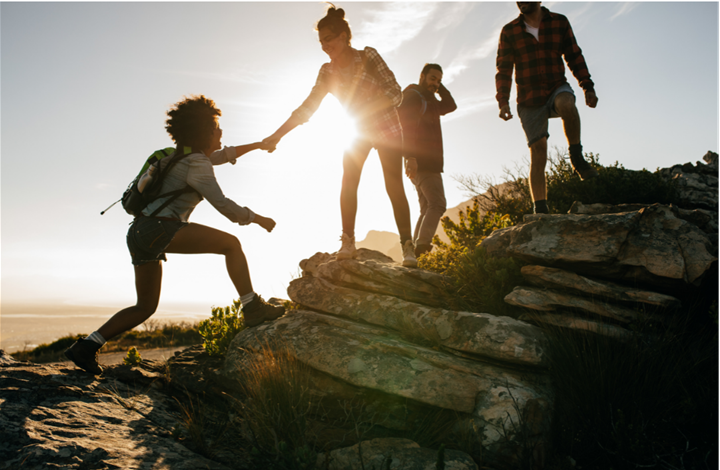
by Guest | Jun 8, 2022 | Being Well
Are you making a difference in the world? Does your life matter? Having a sense of purpose is important to our overall well-being. People with purpose are happier, healthier and more productive. As a result, people who live “on purpose” live longer, better lives. We don’t need to visit a remote cave or mystical community to discover our sense of purpose. The clues are already present within us. Each of us has unique gifts and talents we can intentionally use to lead a more meaningful life.
Purpose Workshops help people identify their gifts and how they can apply them to live their best life. This is especially helpful when exploring relationships, jobs, volunteer opportunities, planning for retirement, and responding to major life events like marriage, divorce, birth and death. Our gifts even nudge us toward certain careers, relationships and even hobbies. If we never intentionally explore our gifts, we may never fully live or experience true joy in life.
During a purpose workshop, you are guided through a process to:
- Identify your gifts,
- Recognize how you apply your gifts, and;
- Use your gifts as sails for getting where you want to go and to navigate storms along the way
Have you ever met someone who just seems full of joy, happy to get out of bed each day no matter their job or what is happening in their lives? Often it is the community volunteer or workplace wellness warrior we see living out their purpose in this way. However, it can also be someone undergoing cancer treatment, or a person experiencing a serious life crisis, who seems to maintain a sense of perspective and an eye toward hope, even during dark times. What these people have in common is that they are tapping into intrinsic traits that bring them joy, peace and contentment, regardless of their circumstances.
While everyone has their own unique gifts, they often go undiscovered. Oliver Wendell Holmes said that most people go to their graves with their music still inside them. On a similar note, there is an ancient story about a man who travels the world over for many years seeking treasure, only to return home as an old man to discover the treasure was buried beneath his house all along. This is so common. We look everywhere, outside ourselves, our whole lives, for the very thing we already possess.
As mentioned earlier, there are clues that help us identify our gifts:
- What we do well and truly love doing
- How we most enjoy serving others
- When we lose track of time doing an activity, often referred to as “flow”
We may know someone who loves their job or a particular volunteer activity. For them the work isn’t work at all. It brings them joy and they actually derive energy from doing the work. Moreover, that energy is often contagious. This is a good sign that someone is living on purpose. When we do things we enjoy, that align with our gifts, whether for our job, in service to others, or as a hobby, we experience a deep sense of satisfaction.
Living a life of purpose is connected to better health and well-being. Research shows that knowing our gifts guides better decision-making, builds resilience and helps us feel like we make a difference in the world.
Through the Blue Zones Project, and in partnership with Tillamook County Wellness, Adventist Health Tillamook is offering free Purpose Workshops. During a guided session, participants can discover (or re-discover) their individual gifts and talents and map out a framework for using their gifts to live a more purpose-oriented and satisfying life.
The 90-minute workshops are offered in-person and virtually (via Zoom) on the third Friday of each month, Noon-1:30 pm, beginning June 17th. There is no charge for the workshops. Registration is required to receive workshop materials and event updates. Watch the Community Calendar for event dates and registration information.
While offered in a group setting, participants will work through their own process to identify their unique gifts, using a personal workbook they can keep after the session. As part of the Tillamook County Wellness This Way to Well-Being campaign, prize drawings will be held at each workshop.
AUTHOR: Michelle Jenck, Adventist Health Tillamook Director of Community Well-Being
Other wellness questions? Email us at info@tillamookcountywellness.org. For more local health and wellness information, visit www.tillamookcountywellness.org or follow Tillamook County Wellness on Facebook and Instagram.
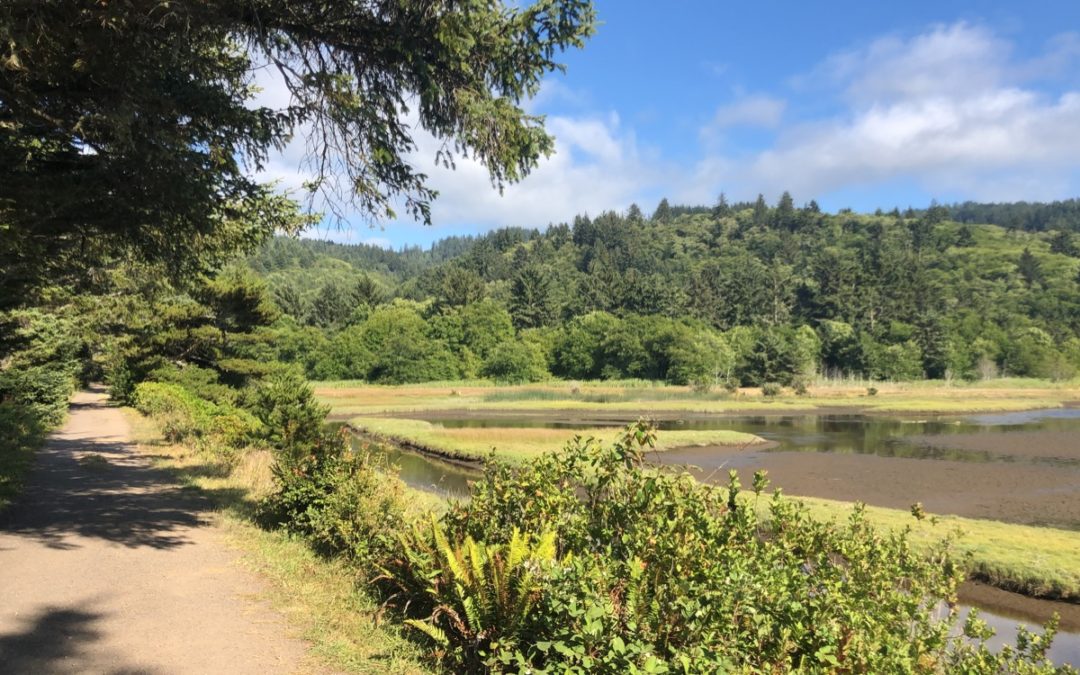
by Guest | May 17, 2022 | Being Well, Move Well
Have you heard about mindfulness? It’s a term that has been popping up a lot recently, from medical journals to social media. The concept and practice of mindfulness however is nothing new. In fact, the basics of what mindfulness is all about has been something humans have practiced, and benefited from, for many thousands of years with the first recorded evidence of the practice tracing back to 1500 BCE, in the Hindu tradition. Today, in the United States, the cultural traditions most frequently associated with mindfulness are Buddhism and Yoga, which comes to us through the Hindu tradition, however, the principles of mindfulness can be found in all religious and spiritual practices that involve setting aside time to find stillness and peace within yourself. It can also be practiced outside of a spiritual experience, in honoring the cosmic miracle of life on Earth, and its origins through peaceful and intentional observation of nature, while sitting on a log.
Why has this practice become an important part of so many different cultures over thousands of years? Well, it’s not because anyone found the act of noticing the way a leaf rustles in the breeze an outrageously exciting experience (particularly when compared to catching some theater at the local amphitheater, or getting the top score on the local laundromat’s pinball machine). Very different people, from very different periods in history have embraced mindfulness in many cases because of the positive benefits to physical and mental health, and improved overall sense of wellbeing. Physical benefits like, relaxed muscle tension and improved quality of sleep. Mental and Emotional benefits including improved resilience to stress, improved regulation of emotions and an increased overall sense of wellbeing.
Another reason mindfulness has found its way into the huts and highrises of humanity comes from the diverse and numerous ways folks can practice it. Based on your cultural tradition, how much bend you’ve still got in your knees, if spending time outdoors is something that motivates you and whether or not you fall asleep within seconds of lying flat and focusing on your breath, you will be able to find some form of mindfulness practice that works for you!
For example, opportunities to practice mindfulness can range from sitting still on a cushion and observing the mental and emotional phenomena bouncing around your mind, and the stillness and peace you can find between them. Or, if you’ve got a bad back, maybe lying down in a supported position and trying deep breathing exercises while bringing awareness to the sensation of your diaphragm doing its part to fill and empty your lungs of vital oxygen and house-plant nourishing CO2. On the other end of the stillness spectrum includes opportunities to practice involving physical movement. Practices like Yoga and Mindful Walking use the perception of movement, the physical sensations that follow, in addition to observing your internal mental and emotional space to explore the possibilities of mindfulness.
Despite all of the options available in practicing mindfulness, many folks are unfamiliar or uncomfortable with the practice. Conditioned by the ways that our lives have become increasingly connected, with our attention primed for constant notifications, buzzes, beeps and alarms, it is even harder but more important that we explore a mindfulness practice. When our brains are used to this kind of environment, we shouldn’t blame ourselves, or attribute any psychic discomfort we feel to a lack of willpower or insufficient self-discipline. When sitting down for the first time in our lives, with the only item on the agenda basically being, “Do nothing, see what happens next”, our minds ask us within seconds, “Are you sure this is a good idea? Maybe something more interesting is happening on social media”. For many people trying a mindfulness practice for the first time, they may not be prepared for what those first few sessions can be like if you are, possibly, in a bit too deep with screen-time. I can speak from personal experience that when you’ve got troubles on the mind, or a looming deadline, or a bad social media habit, that sitting without distraction might seem like the last thing you want to do.
You should expect to crawl before you run, when it comes to mindfulness. Set reasonable goals with your initial sessions, expect to face more than a few urges to get up and grab your smartphone, and keep it to 5 minutes or less. The good news is that even if you don’t get past crawling, with just 1 or 2 minutes at a time, you still benefit through the attempt and practice of giving that part of your cognitive capacity a bit of a workout.
If you are interested in learning more about how you can start your own mindfulness practice, specifically how to practice through walking with mindfulness in nature, Join Tillamook County Wellness on Saturday May 21st 9:00AM – 10:30AM for a guided mindfulness walk at Sitka Sedge Natural Area. The guided walk and instruction session will give you a taste of what mindfulness is all about and send you home with materials you can use to start your own mindfulness practice. One lucky attendee will receive a free Oregon-State-Parks annual parking pass. Parking is free, although limited, so arrive early, carpool if you can, cross your fingers for sun and of course, dress for rain.
This is the first group walking event in a series of monthly events. Watch and register for these free activities on social media and the shared Community Calendar at tillamookcountywellness.org.
You can learn about other steps you can take along the varied paths toward improved health and wellbeing by checking out the Tillamook County Wellness “This Way to Well-Being” map and resource guide.
AUTHOR: Brett Buesnel, AmeriCorps VISTA at Tillamook County Community Health Center
Other wellness questions? Email us at info@tillamookcountywellness.org. For more local health and wellness information, visit www.tillamookcountywellness.org or follow Tillamook County Wellness on Facebook and Instagram.
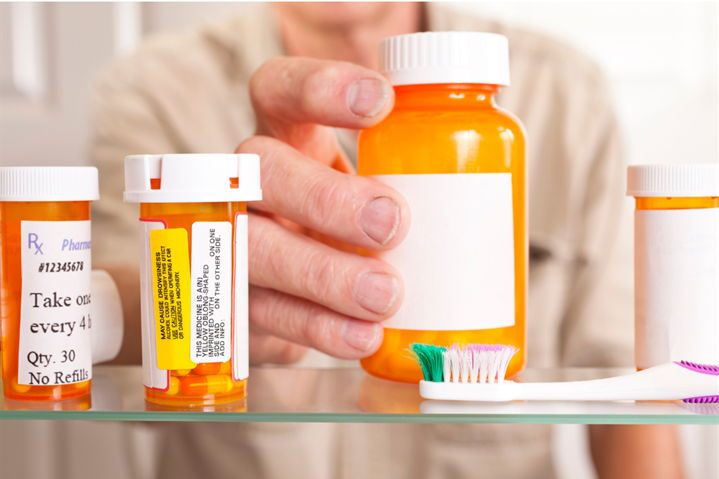
by Guest | May 11, 2022 | Being Well
Many people will take prescription medications at some point. When used as prescribed, these medications can be beneficial in treating medical conditions, maintaining body functions, controlling pain, and treating infections. However, the same medications that are helpful can be dangerous when misused, leading to addiction, poisoning, and overdose. A misuse of medication is anytime a person uses a medication in a way that differs from the instructions provided by the prescriber. Examples of medication misuse include: taking someone else’s medication, sharing medication, taking a higher or lower dosage than was prescribed, taking medication longer than required, taking expired prescription medication, mixing medication with alcohol, and taking the medication in a way that disregards safety instructions.
If you are reading this article and you are currently taking prescription medication, it is essential to have safe medication practices. Here are some safe medication practices that can keep you and those you care about safe:
- Become Knowledgeable about the Medications you are Taking: It is important to be knowledgeable about any medication you are prescribed. Some important information to be knowledgeable about are: reasons why you are taking the medication, possible side effects, dosage information, directions, food and beverages to avoid while taking the medication, and in some cases, a tapering off plan. You can learn about medication by asking your primary care provider, pharmacist, and by reading the manufactures instructions that accompany the prescription.
- Don’t Share Medication: Prescription medication is as unique as the person it is prescribed for. Before a primary care provider prescribes a prescription medication, they consider many factors including the person’s age, height, weight, family history, current medications, addiction history, etc.
- Keep Medicine in a Safe Location: It is important to keep your medication in a safe place. A great place to store medication is in a non-communal room of your home in a hard-to-reach location that children cannot access. To add an additional layer of protection, adults should consider storing all medications in a prescription lock box.
- Safely Dispose of Medication: It is important to dispose of all unused and expired medication safely. Safe disposal methods include taking medication to an official prescription drop off location, or using an at-home prescription disposal kit. Some communities sponsor “Take Back Day” events to encourage safe medication disposal. To find a local safe disposal site near you, visit the drug disposal page at OUR Tillamook. For more information about safe medication disposal, check out the U.S Food and Drug Administration website here.
- Model Safe Medication Practices: Youth often model their behavior based upon the behaviors of parents and caretakers. Because of this, it is important for adults to model safe medication practices by asking a health professional about a prescription medications, taking the correct dosage, properly disposing of medication, and not taking medication with substances such as alcohol.
- Talk with your Children: If you have children, talk with them about medication. In the conversation, discuss the pros and cons of medication, dangers of taking someone else’s medication, family rules, safe medication practices, and let them know that they can come to you if they have further questions. To learn more about how to have these conversations, visit the Substance Abuse and Mental Health Services Administration’s (SAMHSA) Talk They Hear You Campaign.
- Know the Signs of Accidental Poisoning or Overdose: The State of Oregon has a poison control center that has information about accidental poisoning and overdose. Once you know the signs, it is important to know who can help if poisoning or overdose occur. In case of a negative reaction to a drug or accidental ingestion, contact the Oregon Poison Center number at (800)222-1222 (and for life threating emergencies call 911). If you have trouble memorizing the number, try programing it in your phone.
- Take a prevention training: Tillamook Family Counseling Center will be offering an “Introduction to Underage Substance Use and Gambling Prevention” presentation to help caring adults learn more about prevention topics. This will be presented virtually May 9th from 10:00-11:00AM. To learn more, email me at Janeanek@tfcc.org.
- Continue Learning about Safe Medication Practices, Tapering Plans, and Addiction Treatment Services: A few reliable online resources to explore these topics include the Oregon Health Authority, National Institute of Health, Substance Abuse and Mental Health Services Administration. For local information about prevention and treatment for opioid use, visit OUR Tillamook – Local Opioid Use Disorder Resource.
AUTHOR: Janeane Krongos, Tillamook Family Counseling Center
Other wellness questions? Email us at info@tillamookcountywellness.org. For more local health and wellness information, visit www.tillamookcountywellness.org or follow Tillamook County Wellness on Facebook and Instagram.
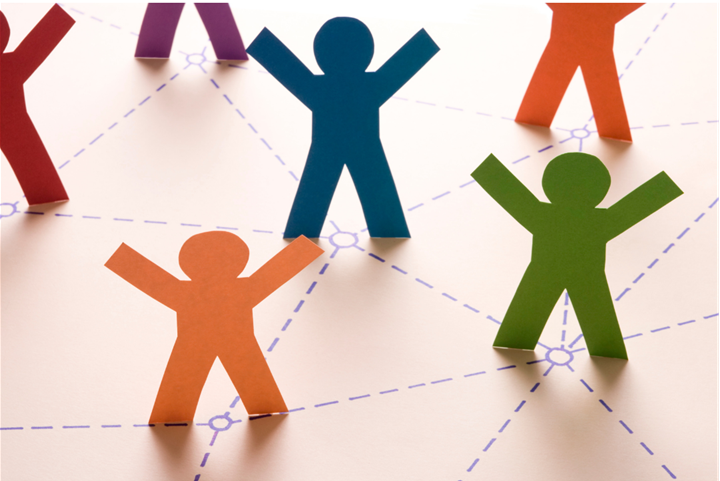
by Guest | May 3, 2022 | Being Well
Each year, people across the nation recognize the month of May as Mental Health Awareness Month. This month-long health observance is a great time for community members to focus on mental health. A few ways community members can observe Mental Health Awareness Month are by learning about mental health topics, identifying local mental health resources, supporting local prevention and treatment efforts, and highlighting behaviors that may help to keep yourself mentally healthy.
Connections can help a person stay mentally healthy. These connections have benefits including increased self-esteem, increased happiness, reduced anxiety, increased empathy, improved relationships, and a greater life purpose. Connections can take place both internally within yourself and externally by interacting with those around you. Three types of connections that are important are connections to yourself, connection with friends and family, and connections to local resources.
Connect with Yourself: Self-care is the act of taking intentional steps to provide yourself with care. Self-care is accessible to anyone, can cost as much or as little as you would like, and does not have to be time consuming. Health screenings, health checkups, eating a balanced diet, staying hydrated, getting quality sleep, grooming, exercising, writing in a journal, breathing exercises, meditation, time management, spending time in nature, and practicing mindfulness are all forms of self-care that you may consider.
Connect with Friends and Family: Connecting with friends and family is a great way to get emotional support, learn from others’ experiences, and to have fun. Community members can maintain their current relationships by keeping in touch, whether that’s by sending a text or email, setting up a video conference meeting, making a phone call, sending a direct message on social media, or meeting up to spend time together. Community members can develop new connections to expand their social circle by volunteering, attending a class or training, joining a club, going to a community event, going to a health center, joining a committee at work, or by joining one of the Tillamook County Wellness walking groups.
Connect to local resources: Four resources to consider are the Tillamook County Wellness’s This Way to Well-Being, Tillamook County Wellness’s website, 2022 Best of Health and Wellness Guide, and prevention programs presented by the Tillamook Family Counseling Center.
- This Way to Well-Being: Tillamook County Wellness’s “This Way to Well-Being” map activity is an activity for both individuals and families. The points of interest on this map are health-focused and divided into categories that represent different aspects of well-being, including activities centered on connecting with yourself and others. These include attending a training, getting an annual check-up, checking in on a loved one, starting a daily gratitude routine, volunteering, and attending a community event. Visit our website to view the map and learn about how you can win a prize for participating in one of these activities.
- Tillamook County Wellness Website: The Tillamook County Wellness (TCW) website is reliable place to get health and wellness information. The website features blogs, a community calendar, and information about local resources. Community members can find resources in the connect-well section of the website. This section includes resources for mental health services, chronic disease management, child development, childcare, community education, financial assistance, access to food, and so much more.
- The 2022 Best of Health and Wellness Guide: This guide has a health and wellness directory, short bios of select local health providers, articles, and other resources. The guide can be downloaded at the Headlight Herald website.
- Tillamook Family Counseling Prevention Programs: Throughout the year, the Tillamook Family Counseling Center offers a variety of programs including underage substance use prevention, problem gambling prevention, suicide prevention, and parent supports. Two programs that will be offered in May are “Introduction to Underage Substance Use and Gambling Prevention” and Question, Persuade, and Refer Gatekeeper training (suicide prevention training). The “Introduction to Underage Substance Use and Gambling Prevention” presentation will be offered virtually May 9th from 10:00-11:00AM. The Question, Persuade, and Refer Gatekeeper training will be offered virtually May 11th from 10:00-11:30AM. For more information about these trainings email janeanek@tfcc.org.
To stay up to date on the latest wellness news be sure to sign up for the TCW newsletter and follow TCW on Facebook and Instagram.
AUTHOR: Janeane Krongos, Tillamook Family Counseling Center
Other wellness questions? Email us at info@tillamookcountywellness.org. For more local health and wellness information, visit www.tillamookcountywellness.org or follow Tillamook County Wellness on Facebook and Instagram.
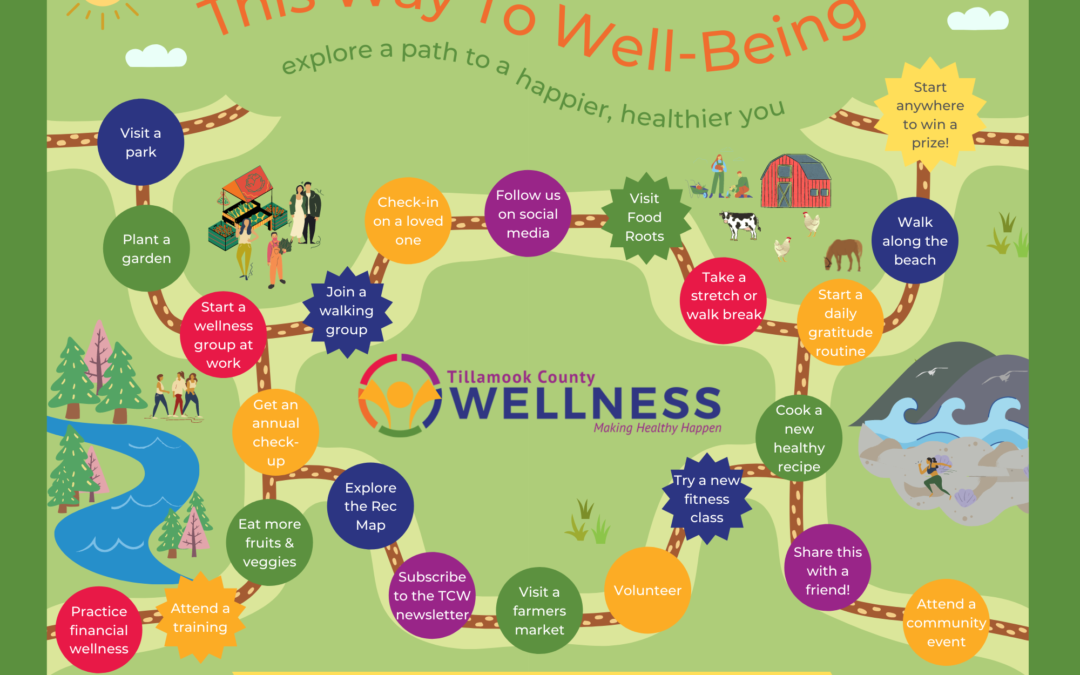
by Guest | Apr 6, 2022 | Archive, Being Well
When you think of the word “wellness”, what comes to mind? For some, images of green juice smoothies and marathons might flash through your mind. But the idea of wellness acknowledges that there is much more to our state of being than just our physical health. Wellness is not just the absence of disease, but something that evolves over time as we strive to live our lives fully. As pointed out by the University of Maryland, “Wellness is fueling your body, engaging your mind, and nurturing your spirit.”
So what exactly does this look like? The answer is a bit different for everyone. There is no “wrong” path to wellness – any steps towards a healthier, happier life are valuable and worthwhile, no matter how small.
The good news is that taking the first step doesn’t need to involve training for a marathon. In fact, there are plenty of options for fun and engaging activities that also benefit your health, whether that’s physically, mentally, or emotionally. For inspiration, we have created a map of local activities here in Tillamook County to help you get started and continue down your own unique journey towards a happier, healthier you. Visit the “This Way to Well-Being” page on our website to see the full map, along with details for each of the stops.
In honor of the idea that well-being is much more than just our physical health, we have collected ideas for exploring different aspects of our lives. You’ll see that our map is color-coordinated:
- The green “eat well” stops represent ideas for enjoying locally produced food, whether this is visiting Food Roots in downtown Tillamook or trying your hand at growing your own produce this spring.
- The orange “connect well” stops offer ideas around prioritizing self-care and connecting with those around us, such as volunteering in the community or calling to check-in on a loved one.
- The blue “move well” stops represent inspiration for exploring the trails, beaches, and parks that are abundant throughout Tillamook County.
- The red “work well” stops acknowledge that we spend much of our time in the workplace and therefore this space is just as important to our health as our personal lives.
- And finally, the purple stops offer a few ways to connect with Tillamook County Wellness as you continue on your path!
It’s worth noting that these activities are often intertwined and therefore the benefits can actually multiply in effect. For example, you can connect with others while also enjoying the outdoors by joining one of the TCW Walking Groups. These groups meet weekly at a range of times and locations across the county (drop-ins welcome!) Click here to find a group near you this spring.
And as an extra perk, participating in activities along the map gives you the chance to win prizes. Anyone in Tillamook County is welcome to participate and individuals will have the opportunity to win more than one prize through any of the following:
- Joining an in-person activity designated by a star shape on the map, such as walking groups, fitness classes, local workshops, or visiting Food Roots
- Posting about your wellness map on Instagram or Facebook and tagging @TillamookCountyWellness
- Sharing your feedback about your experience with activities on the map through our quick online survey found on the map webpage.
You can find the full map on our website, or at your local Tillamook County library branch or another participating location, such as the North County Recreation District (NCRD), Tillamook County Family YMCA, Kiawanda Community Center, and Food Roots. Participants will be eligible to win prizes from April through October 2022 so let us know about your experience through social media, our survey, or by joining an event! Check out our website for details about each stop on the map and reach out to us with any questions at info@tillamookcountywellness.org. We hope that this map can serve as a jumping off point in exploring the fun and engaging opportunities here in Tillamook County for leading a happier, healthier life.
Other wellness questions? Email us at info@tillamookcountywellness.org. For more local health and wellness information, visit www.tillamookcountywellness.org or follow Tillamook County Wellness on Facebook and Instagram.






